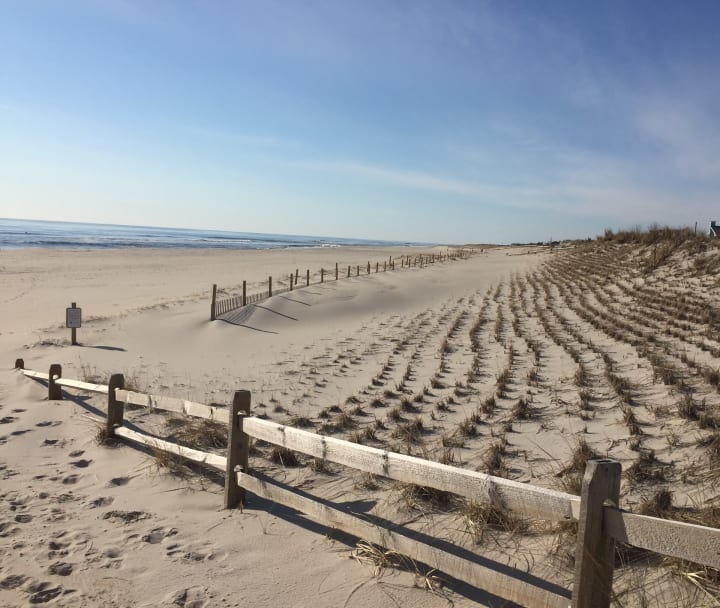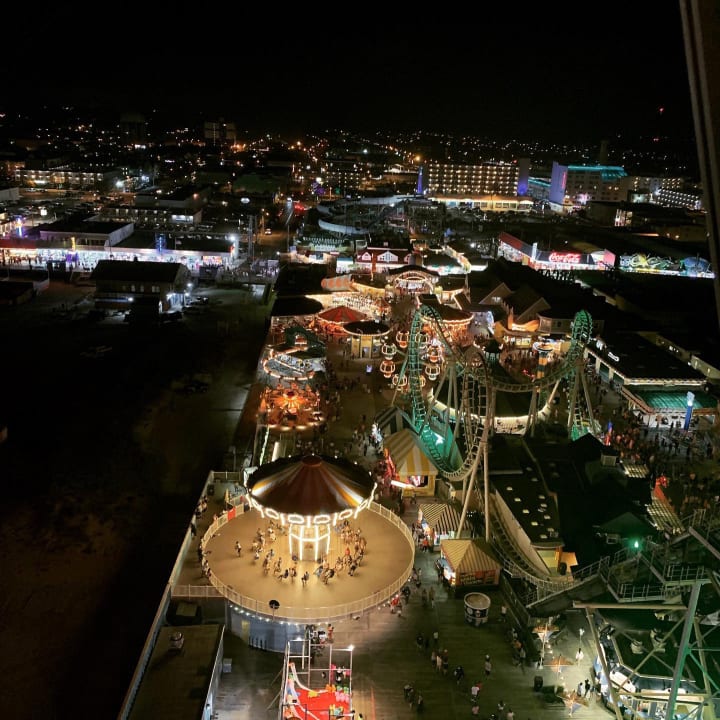What It’s Like Growing up in a Tourist Area
Because no one will believe their vacation spot could ever be dull or unpleasant to a local.

There are certain sights a tourist may never see. In areas that seem like seaside paradise in the summer, it's hard to imagine a snow-covered beach in the winter. People who keep on visiting their favorite vacation places regardless of when the peak season is can get a glimpse of what it's like for locals to watch the ebb and flow of humanity each off-season.
If you’ve lived it, you know exactly what it’s like. But if you’re from one of the places full of people who go flocking to tourist hotspots, then it’s hard to imagine what that tourist paradise is like year-round.
You learn from a young age to simply avoid the tourists.

One of LBI’s many beautiful beaches… taken when I went for a stroll on a freezing cold day of January several years ago.
It’s not that hard, honestly. I grew up in Manahawkin, one of the towns on the mainland right beside the Causeway Bridge leading over to Long Beach Island. For the first 21 years of my life, up until I got my first apartment, this was normal. It was just common knowledge that you needed to time your driving on the weekends around when the tourists would be pouring either on or off the island.
For example, you would not want to venture west to the WalMart or Shop Rite on a Sunday night when everyone was leaving LBI.
You simply find ways to get around the tourists without their presence inconveniencing you too much, just like a wave flowing around a stable rock. You know when the tourists will be around creating traffic; you just do your best to schedule your day-to-day life around it. In most areas, it’s honestly not that impossible.
You may need to get up a bit early to run your errands, but it’s entirely doable. Coexistence is possible without too much trouble.
You may not appreciate the resources or attractions in your area that lure people in.
There are two types of people who live in tourist regions.
- People who utilize the attractions luring tourists to their area.
- People who don’t.
It’s that simple. Either you enjoy what the area offers in your own time, or you ignore it and sink into misery and frustration with the tourists who you barely understand. Believe it or not, there are always quite a lot of people who live in tourist areas but feel this way.
For example, on the mainland just beyond Long Beach Island, I met dozens of people who lived within ten minutes of beautiful sand and sea but would insist that they hated the beach, didn’t like the sand, felt bothered by the seagulls, or despised the smell of low tide. Though I love the beach, I can understand people not liking it; it’s also quite unfortunate for people who have family tying them to an area that generally costs more than quiet suburbia far away from a tourist attraction.
De pending on where you are, it can be pretty tough to enjoy the attraction.
If it’s the beach, it’s pretty easy to enjoy the crashing waves and sea breezes. However, there are genuinely some sad times when tourists... just kind of ruin things. I try very hard to be an optimist, but even I can't justify everything away when it comes to living in a tourist area.
Alternatively, if you live somewhere like Venice, Italy where you can only see the Rialto Bridge and Saint Mark’s Basilica so many times before they just become inconvenient landmarks with nothing more to offer you, it’s a lot harder. In a place like Venice, dealing with hordes of tourists looking to snap a few selfies in front of a historical landmark can be pretty frustrating when you just want to go to work and go home without squeezing through foreigners in rain ponchos.
You get used to most businesses catering to tourists.
It's always a bit amusing to walk into a CVS or Rite Aid and find a huge display of beach gear. Even though it's a chain pharmacy, most stores near the beach will modify their stock accordingly.
It's a common thing in most tourist cities. In 2019, I took a spontaneous trip to Venice. Let’s continue using this historic gem as an example. According to World Population Review, Venice has a formidable 20 million tourists per year, so it’s pretty tough to coexist with such a volume. This data was from before the pandemic, but it's still been primarily a tourist destination for the last several decades.
In these cases, if you can’t move, all you can do is make the best of where you are. For me, I loved the beach and would try to visit at least once a week. If you do live in Venice, perhaps your apartment has a deck overlooking a canal where you can enjoy a glass of wine every Friday.
You get used to comments like “You’re so lucky! You live where I vacation!”

I snapped this picture in Ocean Grove, NJ, on a lucky day where the boardwalk was very quiet and there actually an empty bench. This was pre-pandemic, but it looks like a different world in the summer than it does in the gray winter.
It's particularly common in NJ for people to make funny comments about how lucky you are to live in a vacation destination. Speaking of people who either use or do not use an area’s natural attractions, it can get pretty frustrating when people make this very common observation.
People coming from afar to your home often think that you must have an amazing life if you live in this place that seems like paradise to them.
That may be true to some extent or it straight up may not be. If you live in Baltimore and deal with the choke of tourists melting in with commuters passing through Inner Harbor, you might not feel like you’re able to enjoy your area’s resources at all.
Yet at any rate, what tourists see when they visit is what the locals want them to see. It’s made to be more picturesque and it’s fixed up to ensure tourists keep coming and spending their money to keep the region’s businesses alive. It’s a strange symbiosis.
You get used to having more souvenir stores than grocery stores.
This is one of the tougher ones, honestly. Tourist areas always have almost what you need but not exactly what you need. If you’re really in the thick of the tourist region, then even the most practical building blocks of life, like easy access to a variety of supermarkets, are a bit out of the way.
In Manahawkin, for most of my upbringing, we didn’t have any electronics stores other than the WalMart electronic department and a Radio Shack. (Remember those?)
In general, in the hub of tourist hotspots, there will be more souvenir shops than grocery stores. The nearest department store might be a solid twenty to thirty minutes away. These little inconveniences will start to weigh on people who deal with them constantly.
You know the tide of the region and just how empty and lonely it is in the off-season.
When I was learning how to drive in the cold, cold winter on Long Beach Island, I was faced with a situation I didn’t know how to handle. I was on the main boulevard and suddenly, a real-life tumbleweed started bouncing across the road.
First, there was the utter hilarity of this sight. It was mostly composed of dried out seagrass. We’d always joke about how the island would become a ghost down with tumbleweeds in the winter, but seeing a true to life tumbleweed crossing the road was pretty funny.
Second, how in the world do you handle a tumbleweed from a proper motor vehicle operation standpoint? Do you suddenly stop in the middle of the road and let it pass like you would for a goose? Do you keep driving, let it bounce off your car, and hope it doesn’t scratch it or get stuck?
I ended up going with the former since no one was behind me and let it bounce along.
Regardless, you become very accustomed to the feast and famine of the on-season and the off-season. It’s mayhem when the tourists are around, there’s work to be done, overtime hours to be clocked in, and then when the off-season hits, stores are closed down and not reopened until the tourists return.
Most work in the region is going to revolve around the tourist industry.

The pier was mostly empty in Wildwood, NJ, by the time I made my way up to the Ferris Wheel and took this picture. There are lots of jobs in tourist areas, but the catch is that they may not exactly be the career path you want long-term. Most of the jobs in that region are going to be roles solely dedicated to serving the tourists in some capacity.
This is the hardest part of living in a tourist idea, particularly if you grow up in one. Stores need extra staff, beaches need lifeguards, restaurants need wait staff and cooks. The list could go on for an eternity.
This is true for Long Beach Island, Venice, Italy, Sorrento, Italy, every resort in the Caribbean, and every extremely tourist-focused region in the world. There are cities buzzing with both industry and tourism, like London and Paris, but there are so many other places that are more heavily reliant on the money of people coming from far away.
This often feeds into why locals resent tourists. When you’re constantly forced to serve them, it’s not too hard for resentment to bloom. It takes work to still appreciate an area and show kindness to its guests.
Let’s return to Venice for a moment. The Local, a source of news in Italy translated into English, interviewed many people who live in the tourist hotspot because even though tourism is killing Venice, it’s also the only key to survival.
“Venice is a one-industry city; it relies on tourism, like our bodies rely on food to survive,” said local resident Sebastian Fagarazzi in an interview.
Venice isn’t the only tourist spot in the world that ends up being a one-industry city.
The hardest thing about living in a tourist area is when your professional passion is something the area doesn’t need.
Tourist regions need restaurants, hotels, souvenir shops, and staff for various historical sites or amusement parks. Most tourist regions don’t need a fashion designer, a writer, a graphic designer, or other niche skill sets. If you can make your niche skills feed into a business that does feed the tourists, you’ll be fine, but if you don’t want to fight the battles and trials of self-employment, the few creative jobs in a tourist area are often held by people until retirement.
The reason I bring this up is that this is the only reason why I went from living five minutes from the beach to an hour and five minutes from the beach. I’m a writer and I dabble in graphic design as well. While there are local newspapers and even sometimes local advertising agencies, the amount of jobs open is usually really lacking. The simple fact is it’s a lot easier to pull those skills to use in New York City than it is anywhere along the New Jersey coastline.
Again, it’s certainly possible to build a business around your niche skill or to freelance for local businesses until you’re making a living, but tourist areas have fewer job opportunities than cities with more industries.
About the Creator
Leigh Fisher
I'm a writer, bookworm, sci-fi space cadet, and coffee+tea fanatic living in Brooklyn. I have an MS in Integrated Design & Media (go figure) and I'm working on my MFA in Fiction at NYU. I share poetry on Instagram as @SleeplessAuthoress.






Comments
There are no comments for this story
Be the first to respond and start the conversation.